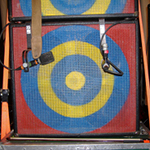Markus Hansen
Unstable Paintings for a Controlled Environment
Virgil de Voldère Gallery
526 West 26th Street, Room 416, New York, NY
February 26–April 4, 2009
Virgil de Voldère is proud to present its third solo exhibition of work by the German-born, Paris-based artist Markus Hansen, his first at the gallery in three years.
As a visual alchemist who explores tainted cultural ideas and their troublesome representations, Hansen transforms personal, cultural, and art-world experiences—in the past he has borrowed imagery from historical German artists, taken photographs from his grandmother’s home, and stacked used champagne flutes from a private art opening into a glowing floor-based chandelier—to simultaneously layer and peel back meaning. Though the artist works in multiple styles and genres—printmaking, photography, film, video, performance, sculpture, and installation—a single distinguishable trait in the current exhibition is his play of opposites: among them light and dark, appearance and emotion, and heritage and history.
Hansen’s imagery is carefully chosen to enhance tainted. In one work, a Hochsitz (a raised, covered structure used for observing or hunting animals) standing in a crowded forest—as dense as an Albrecht Dürer woodcut or a Gustav Mahler musical composition—ominously connotes a military lookout post. In another image, a double eagle that ornately decorates a mirror offers a reflection on historical German symbolism as well as the country’s immediate postwar past. Pictures of turbulent cloudscapes and distant castles on rocky hills above craggy branches and barren landscapes draw attention to sublime experiences and their historical baggage.
The images in the exhibition were prepared digitally, as montages worked in Photoshop, and drawn on paper with gouache, before they are screen-printed onto unprimed canvases with semitransparent ink. Hansen then blows a luminescent powdered pigment across the surface of the wet ink, resulting in a mute beige-yellow surface. Barely perceptible in the light, the images become recognizable as the gallery darkens, the works glowing a soft blue. A nod to institutional critique, Hansen’s attention to the display of art not only foregrounds the exhibition space’s supposed neutral container but it also brings the space into the service of his work. Importantly, in conjunction with the artist’s overall body of work, this tactic interrogates notions of positive and negative, where only in a literal dark space can the viewer metaphorically see clearly.
Playing with visibility and repression, Hansen expands on his personal fascinations with taboos and history to create an art that, while culturally specific in certain ways, is universal and meaningful to a wide audience.
